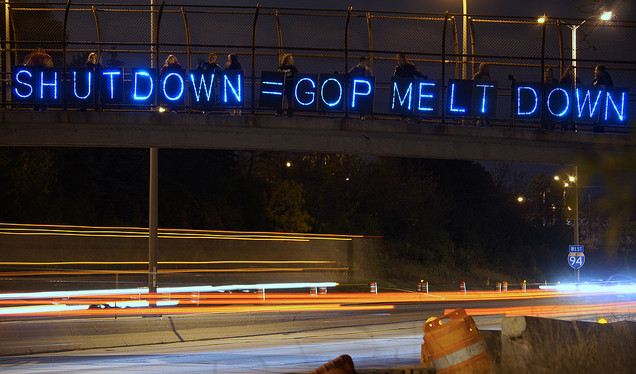If Congress did nothing else effectively in October, it served as a fantastic nicotine patch (metaphorically speaking) for my Breaking Bad withdrawal. This week, the Economist compared the Tea Party’s shutdown antics to “a type of self-affirming performance art.” Other major publications described their actions as “hostage taking” and “toxic.”
‘Performance politics’ accurately describes the Tea Party’s recent political strategy. Given their recalcitrance and recklessness over the course of the month, their exploits would be more appropriate if featured on AMC or HBO, not Capitol Hill. The coalition of representatives drove the federal government into four-week partial shutdown for all the world to see. They brought Congress within hours of the U.S. exhausting its spending authority because of their, quite-literally, uncompromising intent to defund the Affordable Care Act. They terrorized speaker of the House Boehner, leaving him “detached and impotent.” Sen. Ted Cruz engaged in a fake filibuster: a 21 hour marathon speech that virtually served no end other than to publicize his commitment to an “impossible task,” and to smear any Republican lawmaker whose record on the issue demonstrated a shred of compromise. Despite widespread derision and statements from fellow Republicans that any hope of defunding success was a “defiance of the facts,” Cruz’s marathon speech whipped the Tea Party into an ideological frenzy that brought the house down – pun intended.
Headlines say the Republican party is experiencing an internal war between the business-backed, pragmatic, McCain old guard and the ideology-bound Tea Party upshots. From a non-Republican (and a non-federal employee) perspective, the evolving face of legislative political is fascinating. I’m an enthusiastic student of American party politics and the Tea Party has shaken up the two party system like never before.
For the past century the Democrat Republican binary has dominated American politics. Notable disruptions to the system in the last 30 years have come in the form of third party candidates on the presidential ballot, think Ross Perot, Ralph Nader and Ron Paul. Owing to the U.S.’s winner-take-all voting system, however, the lasting powers of the Reform Party, the Green Party, and the Libertarian Party movements have been historically negligible. Media attention for the parties usually lasts as long as each party leader’s presidential campaign.
Against all odds there are now three players in the game. Given the extent to which Democrats and Republicans have co-opted Congress’s structure, it has become virtually impossible for an external third party to maintain legislative power. The Tea Party movement inadvertently circumvented this obstacle by entering Congress as a branch of the Republican Party. It should be noted that Tea Partiers did not operate under the guise of Republicans simply to develop congressional power; Tea Party conservatism is an entirely legitimate faction of the right-wing GOP, albeit more reactionary and pro-small government.
The pioneering nature of the Tea Party’s ascension is that, unlike other grass roots movements swallowed by a greater political party, its leaders refuse to subordinate their cause to the greater will and needs of the GOP. The shutdown debacle and the subsequent “rift,” “schism,” and “civil war” that has overtaken the Republicans is the most recent, and most extreme, demonstration that the Tea Party will not comprise in the course of forwarding their platform, even if it devastates the Republican brand.
During its mission to defund Obamacare, the suicide caucus obstinately withstood anger and criticism from fellow Republicans: Senator Tom Coburn of Oklahoma said their efforts were dishonest and “not an achievable strategy.” Senator Richard Burr of North Carolina was harsher, “It’s the dumbest idea I’ve ever heard of.”
More surprising was the disregard Tea Party representatives had for Republican leaders in the highly hierarchical House. John McCain vocally opposed the coalition’s tactics and has called the Obamacare-showdown “a fool’s errand.” Boehner, the ostensible leader of House Republicans, suffered a public embarrassment, becoming a broker between the Tea Party, the White House and the rest of the GOP. The speaker was forced to negotiate with the suicide caucus on their terms: “The dynamics got much better,” said Representative John Fleming of Louisiana, when Boehner “quit going to the White House to negotiate and he began to listen to us, to what we thought would work.” In the vote to avoid default and reopen the government, Boehner was strong-armed into passing a act without a majority of Republican support (the vote was 285-144 with 87 Republicans supporting the measure.)
While crusading to defund “the most unpopular law ever passed in the history of the country … that intrudes on [citizens’] privacy and our most sacred right as Americans to be left alone,” the Tea Party made an unprecedented impact. It defied the Republican Party machine for the sake of ideological purity and became the closest thing to a third party Congress has seen in the past half century.
In the process it sunk Congress’s and its own approval ratings, and the president expressed outrage that “one faction of one party in one House of Congress in one branch of government,” could cause a government shutdown. Nonetheless, the congressional developments the Tea Party has ushered in provide for incredibly interesting comparisons to European multiparty systems – which I will explore in the second part of this piece. So, again as a non-Republican non-federal employee, I am content to say the madness of the Tea Party might last me until the season three premier of Sherlock.
